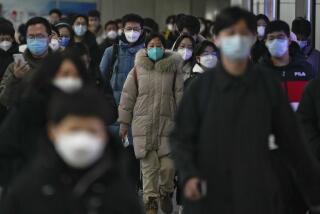WHO Fears Avian Virus May Mutate
- Share via
The lethal avian flu that has infected tens of millions of chickens throughout Southeast Asia has been confirmed in Indonesia -- the seventh country ensnared in what the World Health Organization calls a “historically unprecedented spread” of the disease.
In another disturbing report, WHO also said that the virus has mutated sufficiently to become impervious to two of the most commonly used and inexpensive antiviral drugs, amantadine and rimantadine. It is also not affected by a vaccine that the agency hoped to begin using within a month.
That vaccine was developed against the Hong Kong strain of avian influenza that killed one person there in 2003. The virus responsible for the current episode is substantially different, and WHO spokesmen said that a new vaccine would not be available for at least six months, or until the next flu season.
So far there have been 10 confirmed cases and seven deaths from the disease. The victims had been in direct contact with infected chickens; the virus does not yet appear to be transmitted from human to human.
The greatest fear of researchers at WHO and elsewhere is that, as more humans are infected, the virus will merge with a human influenza virus to produce a more infectious form that will pass readily among humans.
That process is called recombination, and the influenza virus has an unmatched propensity for it, which is why a new flu vaccine must be created each year.
Similar recombinations occurred in 1957 and 1968, producing large-scale flu outbreaks, but those viruses were not as lethal as the current one appears to be.
WHO officials believe the avian flu outbreak has the potential to become a more serious problem than last winter’s SARS outbreak, which infected more than 8,000 people and killed 774. The coronavirus that causes SARS, severe acute respiratory syndrome, is less transmissible among humans than are influenza viruses.
Health officials hope to control the avian flu outbreak before it reaches that stage. “There is a chance that something can go wrong,” Dr. Karl Stohr, head of WHO’s flu program, said Friday in Geneva. With decisive and timely action, he said, it seems “there is a window of opportunity here to control the disease before it takes global proportions.”
Like Thailand before it, Indonesia had adamantly denied the presence of avian flu within its borders, attributing large-scale deaths of chickens to Exotic Newcastle disease, which is not a danger to humans.
But on Sunday, Indonesia’s director-general of animal husbandry, Sofjan Sudardjat, conceded that 40% of the 4.7 million chickens that had died in the country since November were infected with both Exotic Newcastle disease and avian flu.
Indonesian officials said they had stepped up security to prevent transmission of the virus among farms, but they had not yet ordered large-scale culling of chicken flocks. Killing infected birds is generally considered the best way to halt the spread.
Culling is now proceeding in the other six countries afflicted by the problem: Thailand, Vietnam, Japan, Cambodia, South Korea and Taiwan. That process, although necessary, actually increases the risk of the disease spreading to humans because workers must come in close contact with the animals to kill them.
If infected, the workers might serve as hosts for the virus’ complex mating dance.
WHO has urged caution in the culling process, recommending that workers wear full protective gear and that they be vaccinated or given protective drugs.
But the gear and drugs are expensive and beyond the means of many of the countries involved in the outbreak.
There also are hints that the culling process may not be completely effective.
The new strain of the virus has already been found in at least one bird of prey, and observers also have spotted groups of dead wildfowl.
If the virus becomes widespread in wild birds, they could serve as a source for reinfecting flocks that have been purged of the virus.
The first documented spread of avian flu to humans occurred in Hong Kong more than six years ago when the virus caused respiratory failure in 18 people and killed six.
To control the outbreak, every chicken in Hong Kong was slaughtered.
More to Read
Sign up for Essential California
The most important California stories and recommendations in your inbox every morning.
You may occasionally receive promotional content from the Los Angeles Times.










